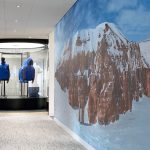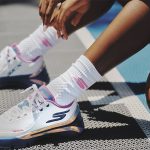The terrific ski conditions in the West, and record skier visits at many resorts were balanced out this year by bitter cold and an abundance of ice in the east. Still the SIA retail audit for the entire 2003-2004 retail season showed some respectable growth in the industry. Sales for the entire SnowSports retail marketplace grew 0.6%, or $13 million to $2.213 billion through the end of March.
Specialty ski and snowboard shops overcame some profound price deflation and held on to a sales increase of 0.4% from $1.712 billion last year to $1.719 billion this year. Most of the declining prices came from the ski side of the industry, as the average selling price of a pair of skis dropped 10%, and in just about every equipment category, unit sales out-paced dollar sales.
Chain stores fared somewhat better than specialty and did not experience the drop in average selling prices that the specialty sector saw. Chain store SnowSports sales increased 1.4% from $487.4 million in the 2002-03 season to $493.8 million in the 2003-04 season. The average selling price of a pair of skis only dropped 5% at chain stores, and carve skis actually experienced a 44% increase in price.
Both alpine and snowboard apparel showed solid sales growth at specialty shops, increasing 6% and 17% respectfully. Total (alpine & snowboard combined) apparel sales grew 14% in units and 8% in dollars. The category leaders were soft-shells, which grew 111% in units and 109% in dollars, and insulated parkas, which showed a sales increase of 20% in units and 17% in dollars.
At the end of the season specialty SnowSports shops accounted for 77.7% of the total sales in the SnowSports market. This is down slightly – 10 basis points lower than the 77.8% posted last year.
Insulated parka sales were driven primarily by the cold conditions in the east, but sales of womens insulated parkas outpaced the category average, showing a 29% increase in units and a 23% increase in dollars.
Chain store sales were not driven by apparel this year, in fact there was a 12% unit decline and a 1% dollar decline. However, womens apparel did quite well, with shell parkas showing a 23% increase in units and a 33% increase in dollars. Men's shell parkas declined 24% in units and 17% in dollars.
Specialty stores seemed to have a hard time with alpine hard-goods this year. Alpine equipment inventories at the end of this season were 14% higher than they were at the same time last year. Integrated ski systems and fat skis were the saving grace for the category. Systems posted a 43% increase in Units sold and 24% increase in dollars, while fat skis grew 26% in units and 19% in dollars.
Alpine equipment continued to struggle at chain stores as well, falling 5% in units sold and 3% in dollars. Again ski systems lead the way for the chain store, showing a 98% increase in units, but a $29 decrease in average selling price kept the dollar increase somewhat lower. The chain stores did show some ability to react to developing trends this year showing a 54% unit increase in fat skis and a 20% unit increase in twin-tip skis.
Telemark skis showed some rapid growth at specialty shops for the 2004 season with a 74% increase in units and 62% increase in dollars, but the growth is from some relatively small numbers. A total of 7,400 pairs were sold throughout the season. Veteran alpine skiers are clearly converting their old equipment over to telemark as boots and bindings outpaced telemark skis with an 84% increase in units at specialty.
At chain stores Nordic and telemark sales were a strong performer too; sales reached $9.9 million for the two categories combined, with the average retail price rising considerably.
Snowboard equipment showed some a very strong performance at specialty shops, growing 16% in dollars and units. The higher demand for snowboard equipment seems to have held off the price deflation experienced in most of the alpine categories.
Even though the average selling price of all snowboards held steady at specialty shops compared to last season, carry-over snowboards showed the most growth in sales. The category grew 60% in units and 65% in dollars, an indication that retailers are not discounting last years models as deeply as they once were.
Snowboard equipment did not fare as well at chain stores as it did at specialty, falling 12% in units and 2% in dollars. Declining snowboard sales turned around at the end of the season, and chain stores actually posted an increase in the number of boards sold of 6%, and a 2% dollar increase. The average retail price of a snowboard dropped $5 at chain stores this season.
The SIA also pointed out several initiatives that the industry can take up to help to grow the sport and boost sales. Looking for new customers is always an important goal of any retailer, and the SIA has noticed a few that may be neglected.
Currently there is a clear focus on marketing to the younger generation, and this focus will propel sales for the next decade. At the Snow Industry Summit this year several attendees asked questions about how to grow the non-Caucasian segment of the SnowSports population, and now the SIA is addressing this.
The National Brotherhood of Skiers represents more than 80 all Black ski clubs across the country. Even more impressive is that the organization has retained 70% of all of the people they have introduced to the sport.
Supporting the NBS is not necessarily the only solution to creating a more diverse SnowSports world, but working with them to find a solution is certainly a step in the right direction.
>>> Many vendors and retailers are concerned with diversifying SnowSports demographics; contacting small organizations like NBS and starting a grass-roots campaign is a sure-fire way to get the ball rolling…














